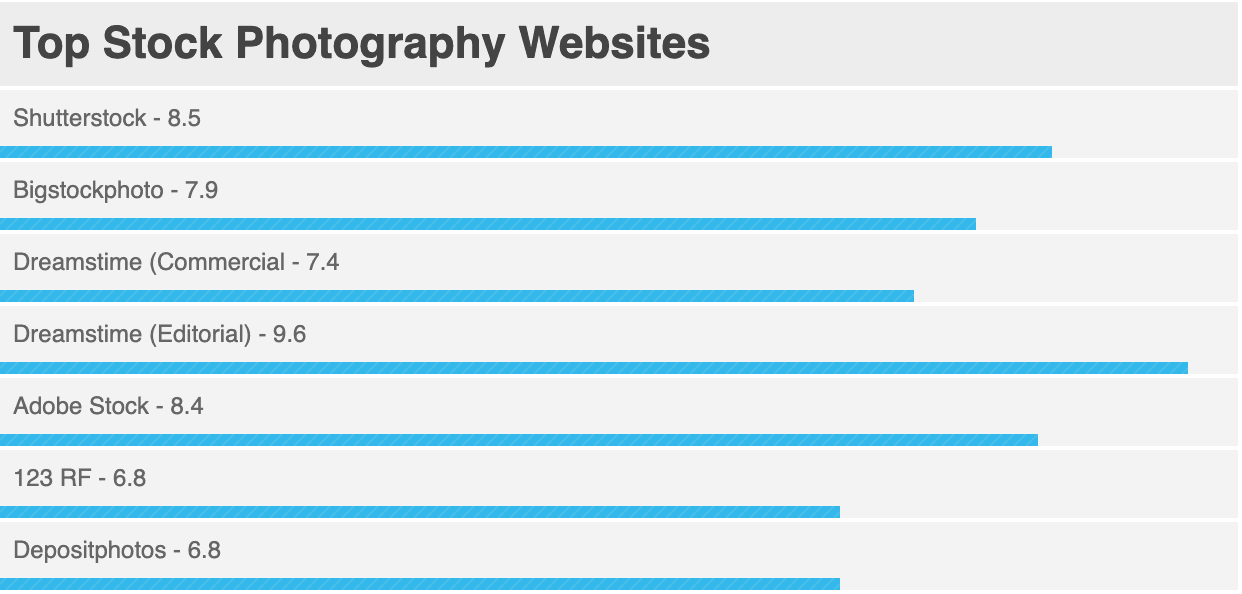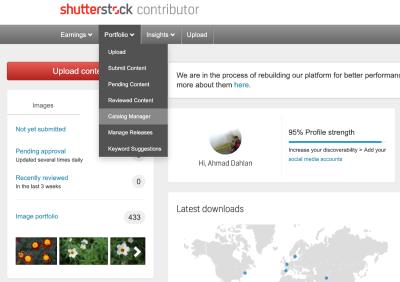If you’re passionate about photography and looking for a way to turn your hobby into a source of income, Shutterstock might just be the platform you’re searching for. As one of the biggest stock photo websites out there, Shutterstock offers photographers the chance to showcase their work to millions of potential buyers worldwide. Whether you’re a seasoned pro or just starting out, understanding how
Factors Influencing Photographer Earnings on Shutterstock
When it comes to earning money on Shutterstock, a lot depends on several important factors. Think of it like a recipe—you need the right ingredients to maximize your earnings. Here’s a breakdown of what really impacts how much you can make:
- Contributor Level: Shutterstock has a tiered system—Standard, Plus, and Portfolio. As you upload more high-quality images and earn more, you climb the ranks. Higher tiers often unlock higher royalty rates, so consistency and quality are key.
- Image Quality and Relevance: The better your photos look and the more relevant they are to current trends, the more likely they are to be downloaded. Sharp, well-lit, and professionally composed images tend to perform better.
- Keyword Optimization: Properly tagging your images with accurate and descriptive keywords makes it easier for buyers to find them. Think of keywords as the map that guides interested customers to your work.
- Content Niche: Some niches tend to sell better than others. For example, business, healthcare, and technology images often see higher demand. Specializing in a profitable niche can boost your earnings.
- Upload Frequency and Consistency: Regularly uploading fresh content keeps your portfolio active and improves visibility. The more quality images you offer, the more chances you have for sales.
- Pricing and Licensing: Shutterstock offers different licensing options—standard and enhanced. Understanding how these affect your earnings can help you optimize your pricing strategy.
- Market Trends and Demand: Staying updated on current trends and popular themes can give your portfolio a competitive edge. For example, during certain seasons or events, themed images might see a spike in downloads.
Ultimately, your earnings are a combination of these factors working together. While some photographers might see steady income from a handful of high-quality images, others might grow their earnings by consistently uploading large volumes of content in high-demand niches. The key is to stay committed, continually improve your skills, and keep an eye on what buyers are looking for. With patience and strategic effort, Shutterstock can be a lucrative platform for photographers eager to share their vision and make money doing what they love.
Average Income Range for Shutterstock Contributors
So, you’re curious about how much you might earn as a Shutterstock contributor? Well, the truth is, it varies quite a bit depending on several factors like the quality of your images, how many you upload, and how popular they become. But to give you a general idea, most photographers on Shutterstock see earnings ranging from just a few dollars a month to several hundred, or even thousands, if they’re prolific and their work hits the right notes.
On average, new contributors often start out earning around $0.25 to $1 per download. This might not sound like much, but as you build your portfolio and improve your photography skills, your earnings can increase. Some of the top contributors, who upload consistently high-quality images that are in demand, report earning $1,000 or more per month.
It’s also helpful to understand that Shutterstock pays contributors based on a tiered royalty system. The more downloads your images get, the higher your percentage cut becomes. For example, contributors earning less than $500 in a year might receive a royalty rate of around 15-20%. Once you reach higher earning thresholds, your royalty percentage can increase to about 30-40%. This means that active and successful contributors can significantly boost their income over time.
Here’s a quick snapshot to help visualize the earning potential:
- Beginners: Typically earn around $0.25 to $1 per download, with monthly earnings under $50.
- Intermediate contributors: With more uploads and higher-quality images, earn $50 to $300 per month.
- Top contributors: Can earn $1,000 or more monthly, especially with popular images that go viral or are in high demand.
Remember, consistency is key. The more quality images you upload, the more chances you have of making a steady income. And don’t forget, passive income from stock photography can grow over time as your portfolio expands and your images become more popular.
How Shutterstock Payment Structure Works for Photographers
Understanding how Shutterstock pays its contributors is crucial if you want to maximize your earnings. The platform operates on a royalty-based system, which means you earn a percentage of the sale each time one of your images is downloaded. But it’s a bit more detailed than that, so let’s break it down.
First off, Shutterstock has a tiered royalty structure. When you first start, your earnings per download are usually around 15-30% of the license fee, depending on your contributor level. As you accumulate more earnings and reach specific milestones, your royalty rate increases. For example:
| Contributor Level | Annual Earnings | Royalty Rate per Download |
|---|---|---|
| Standard | $0 – $499 | 15% |
| Advanced | $500 – $4,999 | 20-30% |
| Elite | $5,000+ | 30% |
Furthermore, Shutterstock offers different licensing options—standard and enhanced. Standard licenses are for most uses, like websites or personal projects, while enhanced licenses are for larger commercial applications. The license type affects how much the customer pays, and consequently, how much you earn.
Payments are made monthly, usually around the 15th of each month, providing you have accumulated at least $35 in earnings. If you earn less than this threshold, your earnings roll over to the next month until you reach the minimum payout.
Shutterstock also provides a referral program where you can earn additional income by referring new contributors. Plus, there are occasional bonuses or promotional opportunities that can give your earnings a little boost.
In summary, the payout structure rewards consistent and high-quality uploads. The more your images are viewed and downloaded, the more you earn, especially as you climb the contributor levels. It’s all about building a diverse and appealing portfolio, understanding licensing, and keeping an eye on your progress.
Tips to Maximize Your Earnings on Shutterstock
So, you’re ready to boost your income on Shutterstock? That’s fantastic! The good news is, with a few strategic moves, you can increase your earnings and make your photography work more rewarding. Here are some practical tips to help you get the most out of your Shutterstock portfolio:
- Focus on High-Demand Topics: Keep an eye on trending subjects and popular themes. Shutterstock often features images related to current events, seasons, or viral topics. Doing some research on what buyers are looking for can help you create content that sells.
- Capture Versatile Shots: Upload images that are adaptable across various uses. Think about including different angles, backgrounds, and compositions. The more versatile your photos, the wider their appeal.
- Maintain Consistent Quality: High-quality images perform better. Invest in good equipment and editing tools, and learn basic photography and post-processing skills. Clear, sharp, well-lit images tend to attract more downloads.
- Use Relevant Keywords: Proper keywording is essential. Think like a buyer—what words would they type to find your photo? Use accurate, descriptive keywords to improve your images’ visibility in searches.
- Upload Regularly: Consistency is key. The more you upload, the higher your chances of being seen. Set a schedule that works for you and stick to it, so your portfolio keeps growing and stays fresh.
- Participate in Challenges and Promotions: Shutterstock sometimes runs contests and promotional events. Participating can give your work extra visibility and sometimes even earn you bonuses.
- Analyze Your Performance: Use Shutterstock’s analytics tools to see which images are performing well. Pay attention to patterns—what types of images get more downloads? Use this data to guide your future uploads.
Remember, patience and persistence pay off. Building a successful stock photography portfolio takes time, but with these strategies, you can accelerate your earnings and enjoy the journey along the way!
Pros and Cons of Selling Photos on Shutterstock
Like any platform, Shutterstock has its advantages and disadvantages. Knowing these can help you decide if it’s the right place for your photography career. Let’s break down some of the main pros and cons:
Pros:
- Global Exposure: Shutterstock is one of the largest stock photo platforms worldwide, meaning your images can reach millions of potential buyers across different countries.
- Passive Income Potential: Once uploaded, your images can generate income over time with little ongoing effort. The more popular your photos, the more they can earn passively.
- Easy Submission Process: Uploading photos is straightforward, with user-friendly tools and clear guidelines to help you get started quickly.
- Multiple Revenue Streams: Besides standard sales, Shutterstock offers options like subscription downloads and extended licenses, which can boost your earnings.
- Community and Resources: Shutterstock provides tutorials, forums, and support to help you improve your skills and grow your portfolio.
Cons:
- High Competition: With thousands of contributors, standing out can be challenging. Your images need to be unique and high quality to get noticed and sell.
- Lower Earnings per Download: Shutterstock’s royalty rates can be relatively modest, especially for new contributors or images with fewer downloads. It may take time to build up significant income.
- Strict Submission Guidelines: Your photos must meet specific quality standards and adhere to licensing rules. Rejections can be frustrating, but they help maintain platform quality.
- Limited Control Over Pricing: Shutterstock sets the pricing structure, and contributors earn a percentage rather than setting their own prices. This can limit your earning potential per image.
- License Risks: Once your images are online, they are accessible to anyone, which increases the risk of unauthorized use or misuse. Proper watermarking and licensing can help mitigate this.
Ultimately, Shutterstock offers an excellent opportunity for photographers to generate income, especially if you’re willing to put in the effort to create high-quality, in-demand images. However, understanding the platform’s challenges helps you set realistic expectations and develop strategies to succeed. Weighing these pros and cons can guide you in making informed decisions about your stock photography journey.
Real-Life Success Stories from Shutterstock Photographers
One of the most inspiring parts of exploring Shutterstock is hearing from photographers who turned their passion into a steady income stream. These success stories aren’t just about hitting it big—they show that with dedication, strategy, and a bit of patience, earning a decent living is possible. Let’s dive into a few real-life examples.
Meet Sarah, a travel photographer who started uploading her images to Shutterstock as a hobby. Over time, her portfolio grew to include thousands of images from her adventures around the world. She focused on popular themes like cityscapes, landscapes, and cultural portraits. Within a couple of years, her earnings averaged around $1,200 per month. Sarah credits her success to consistent uploads, keyword optimization, and engaging with the Shutterstock community for feedback and tips.
Then there’s Mike, a hobbyist nature photographer who made the leap into full-time stock photography. He specialized in wildlife and outdoor scenes, aiming to capture unique moments. Mike’s strategic approach involved researching trending topics and seasons, so he uploaded images that matched current demand. His earnings peaked at $3,500 in a month, enabling him to replace his previous part-time job. Mike emphasizes the importance of quality over quantity and staying active on the platform to increase visibility.
And let’s not forget about Lisa, who initially uploaded images as a side project. She diversified her portfolio with illustrations and lifestyle shots. Over a few years, her monthly earnings stabilised at about $2,000. Lisa highlights the importance of diversity in your portfolio and keeping an eye on what buyers are searching for. She also recommends engaging with the Shutterstock community and participating in forums for extra tips and motivation.
What these stories have in common is persistence and understanding the market. Success on Shutterstock doesn’t happen overnight, but these photographers show that with consistent effort and strategic thinking, you can turn your photography into a viable income source. Every photographer’s journey is different, but their stories prove that earning money on Shutterstock is not just a pipe dream—it’s entirely achievable with the right approach.
Conclusion: Is Shutterstock a Viable Income Source for Photographers?
So, after exploring the ins and outs of Shutterstock earnings and hearing from those who’ve walked the path, you might be wondering—is Shutterstock a viable income source for photographers?
The honest answer? It can be, but it depends on your goals, effort, and approach. For hobbyists and part-time photographers, Shutterstock offers a fantastic platform to earn some extra cash, showcase your work, and build a portfolio. Many creators find that even modest earnings add up over time, providing a nice supplementary income.
For those looking to make a full-time living from stock photography, it’s certainly possible—but it’s not a get-rich-quick scheme. Success requires:
- Consistency: Regular uploads keep your portfolio active and visible.
- Quality: High-quality images attract more buyers and earn higher royalties.
- Market research: Understanding what buyers want and trending topics helps your images stand out.
- Optimized keywords and descriptions: These improve discoverability and sales.
It’s also important to keep expectations realistic. While top contributors can earn thousands monthly, most photographers see a gradual increase in earnings over time. The key is perseverance and continuous learning.
Ultimately, Shutterstock can be a viable income stream—especially if you treat it as a long-term project. It won’t replace a traditional job overnight, but with dedication, it can become a reliable source of income and a rewarding way to share your creativity with a global audience.
If you’re passionate about photography and eager to explore new revenue avenues, giving Shutterstock a shot might just be worth your while. Remember, every big success starts with a single upload—so why not start today?



